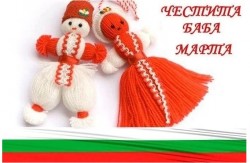HAPPY BABA MARTA - HOW Bulgaria CELABRATE THAT DAY
 MARTENITSA The Bulgarian wish for good Health, Strength and Happiness
MARTENITSA The Bulgarian wish for good Health, Strength and HappinessThe Martenitsa, given as an amulet in the period of spring, when nature gets “reborn” and starts blossoming again it was not only a reminder of that balance but also a wish for health, strength and happiness. The Martenitsa, or Pijo and Penda, is a Bulgarian tradition celebrating the arrival of spring. The martenitsa takes the form of a small piece of adornment, made of white and red yarn and worn from March 1st until the 22nd March (or until the first time an individual sees a stork or a swallow). Mart (март) is the Bulgarian word for the month of March. The name of the holiday is Baba Marta, a Bulgarian tradition related to welcoming the upcoming spring. The month of March, according to Bulgarian folklore, marks the beginning of springtime. Therefore, the first day of March, Granny Martha's Day, is a traditional holiday associated with sending off of winter and the welcoming of spring. Romanians also have a similar but not identical holiday on March 1, called "Martisor".
The red and white woven threads are not just meaningless decoration, but symbolize the wish for good health. They are the heralds of the coming of spring in Bulgaria and life in general. While white as a colour symbolizes purity and soul, red is a symbol of life and passion, thus some ethnologists have proposed that in its very origins the custom might have reminded people of the constant cycle of life and death, the balance of good and bad, of sorrow and happiness in human life.
On the first day of March and few days afterwards, Bulgarians exchange and wear white and red tassels or small dolls called "Пижо и Пенда" (Pizho and Penda). In Bulgarian folklore the name Baba Marta (in Bulgarian баба Марта meaning Grandma March) is related to a grumpy old lady whose mood swings change very rapidly.
This is an old pagan tradition and it remains almost unchanged today. The common belief is that by wearing the red and white colours of the martenitsa people ask Baba Marta for mercy. They hope that it will make winter pass faster and bring spring. Many people wear more than one martenitsa. They receive them as presents from relatives, close friends and colleagues. The Martenitsa is usually worn pinned on the clothes, near the collar, or tied around the wrist. The tradition calls for wearing the martenitsa until the person sees a stork or a blooming tree. The stork is considered a harbinger of spring and as evidence that Baba Marta is in a good mood and is about to retire.
The ritual of finally taking off the martenitsa may be different in the different parts of Bulgaria. Some people would tie their martenitsa on a branch of a fruit tree, thus giving the tree health and luck, which the person wearing the martenitsa has enjoyed himself while wearing it. Others would put the martenitsa under a stone with the idea that the kind of the creature (usually an insect) closest to the token the next day will determine the person's health for the rest of the year. If the creature is a larva or a worm, the coming year will be healthy, and full of success. The same luck is associated with an ant, the difference being that the person will have to work hard to reach success. If the creature near the token is a spider, then the person is in trouble and may not enjoy luck, health, or personal success.
We have highly recommend Kunka Boneva and her agency - BULGARIAN HOUSE LTD - to any friend, relative, business associate or client looking to sell or buy their property in Bulgaria. We have used her services several times and we’re always delighted with her high level of service, knowledge and professionalism. Kiki works extremely hard and analyzes the market and your personal situation to ensure you get the best price and fit. She and her team treats you like you are the most important client and doesn’t pressure you to close the deal. She is sensitive to the fact she is dealing with people s homes and the related past or future memories. Buying or selling your Bulgarian home can be a stressful and emotional experience. With Kunka as your team, you can be sure the experience is both enjoyable and profitable.
— Steve & Sabrina Rouses, USA

